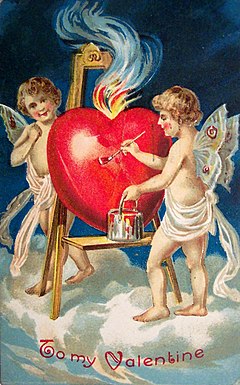Valentine's Day, also known as Saint Valentine's Day or the Feast of Saint Valentine,[1]
is a celebration observed on February 14 each year. It is celebrated in
many countries around the world, although it is not a public holiday in
most of them.
St. Valentine's Day began as a liturgical celebration of one or more early Christian saints named Valentinus. Several martyrdom stories were invented for the various Valentines that belonged to February 14, and added to later martyrologies.[2] A popular hagiographical account of Saint Valentine of Rome states that he was not imprisoned for performing weddings for soldiers who were forbidden to marry and for ministering to Christians, who were persecuted under the Roman Empire. According to legend,
during his imprisonment, he healed the daughter of his jailer,
Asterius. An embellishment to this story states that before his
execution he wrote her a letter signed "Your Valentine" as a farewell.[3] Saint Valentine's Day is an official feast day in the Anglican Communion,[4] as well as in the Lutheran Church.[5] Some part, but not all of the Eastern Orthodox Church also celebrates Saint Valentine's Day, albeit on July 6 and July 30, the former date in honor of the Roman presbyter Saint Valentine, and the latter date in honor of Hieromartyr Valentine, the Bishop of Interamna (modern Terni). In Greek Orthodox Church and other Churches of the Ecumenical Patriarchate, no Saint Valentine exists, nor venerated.
The day was first associated with romantic love in the circle of Geoffrey Chaucer in the High Middle Ages, when the tradition of courtly love flourished. In 18th-century England, it evolved into an occasion in which lovers expressed their love for each other by presenting flowers, offering confectionery, and sending greeting cards (known as "valentines"). In Europe, Saint Valentine's Keys
are given to lovers "as a romantic symbol and an invitation to unlock
the giver’s heart", as well as to children, in order to ward off epilepsy (called Saint Valentine's Malady).[6] Valentine's Day symbols that are used today include the heart-shaped outline, doves, and the figure of the winged Cupid. Since the 19th century, handwritten valentines have given way to mass-produced greeting cards.
HISTORY:
Numerous early Christian martyrs were named Valentine.[10] The Valentines honored on February 14 are Valentine of Rome (Valentinus presb. m. Romae) and Valentine of Terni (Valentinus ep. Interamnensis m. Romae).[11] Valentine of Rome was a priest in Rome who was martyred about AD 496 and was buried on the Via Flaminia. The relics of Saint Valentine were kept in the Church and Catacombs of San Valentino
in Rome, which "remained an important pilgrim site throughout the
Middle Ages until the relics of St. Valentine were transferred to the
church of Santa Prassede during the pontificate of Nicholas IV".[12][13] The flower-crowned skull of Saint Valentine is exhibited in the Basilica of Santa Maria in Cosmedin, Rome. Other relics are found at Whitefriar Street Carmelite Church in Dublin, Ireland.[14]
Valentine of Terni became bishop of Interamna (modern Terni) about AD 197 and is said to have been martyred during the persecution under Emperor Aurelian.
He is also buried on the Via Flaminia, but in a different location from
Valentine of Rome. His relics are at the Basilica of Saint Valentine in
Terni (Basilica di San Valentino). Jack B. Oruch states that "abstracts of the acts of the two saints were in nearly every church and monastery of Europe."[15] The Catholic Encyclopedia also speaks of a third saint named Valentine who was mentioned in early martyrologies under date of February 14. He was martyred in Africa with a number of companions, but nothing more is known about him.[16] Saint Valentine's head was preserved in the abbey of New Minster, Winchester, and venerated.[17]
February 14 is celebrated as St. Valentine's Day in various Christian denominations; it has, for example, the rank of 'commemoration' in the calendar of saints in the Anglican Communion.[4] In addition, the feast day of Saint Valentine is also given in the calendar of saints of the Lutheran Church.[5] However, in the 1969 revision of the Roman Catholic Calendar of Saints, the feast day of Saint Valentine on February 14 was removed from the General Roman Calendar
and relegated to particular (local or even national) calendars for the
following reason: "Though the memorial of Saint Valentine is ancient, it
is left to particular calendars, since, apart from his name, nothing is
known of Saint Valentine except that he was buried on the Via Flaminia
on February 14."[18]
The feast day is still celebrated in Balzan (Malta) where relics of the saint are claimed to be found, and also throughout the world by Traditionalist Catholics who follow the older, pre-Second Vatican Council calendar. In the Eastern Orthodox Church, St. Valentine's Day is celebrated on July 6, in which Saint Valentine,
the Roman presbyter, is honoured; furthermore, the Eastern Orthodox
Church observes the feast of Hieromartyr Valentine, Bishop of Interamna,
on July 30
VALENTINE WILL BE FUN WITH MY BAE.... COME JION ME @5STAR HOTEL










0 comments:
Post a Comment